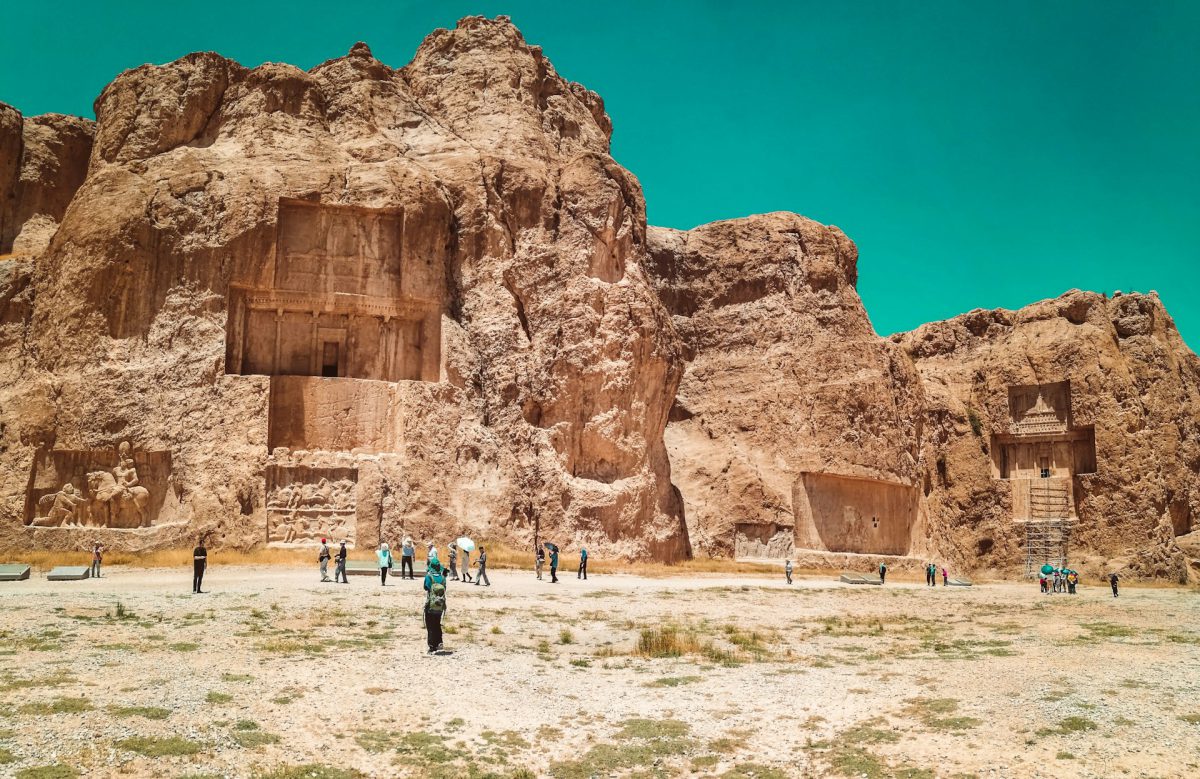Table of Contents
Naghsh-e Rostam, located just a few miles from Persepolis, is a stunning testament to the grand visions of Darius the Great. In this incredible complex, towering tombs hewn out of vertical rock face stand as a testament to the might and power of the Achaemenid kings.
Contrary to the traditional architectural formula of creating mausoleums in the form of houses, Darius the Great opted for a completely different approach in Naqsh-e Rostam. Here, colossal tombs were directly cut out of the mountain face, creating a singularly unique visual experience for visitors. These tombs are not only monumental but also visible from afar, adding to their grandeur and majesty.
Though the tombs were built thousands of years ago, the intricate carvings and engravings still remain remarkably well-preserved, attracting tourists and history buffs from all over the world. Naqsh-e Rostam is an unmissable destination for anyone with an interest in Iran history and culture, offering a glimpse into the impressive vision and grandeur of the Achaemenid kings.
Naghsh-e Rostam Architecture and Sculpture
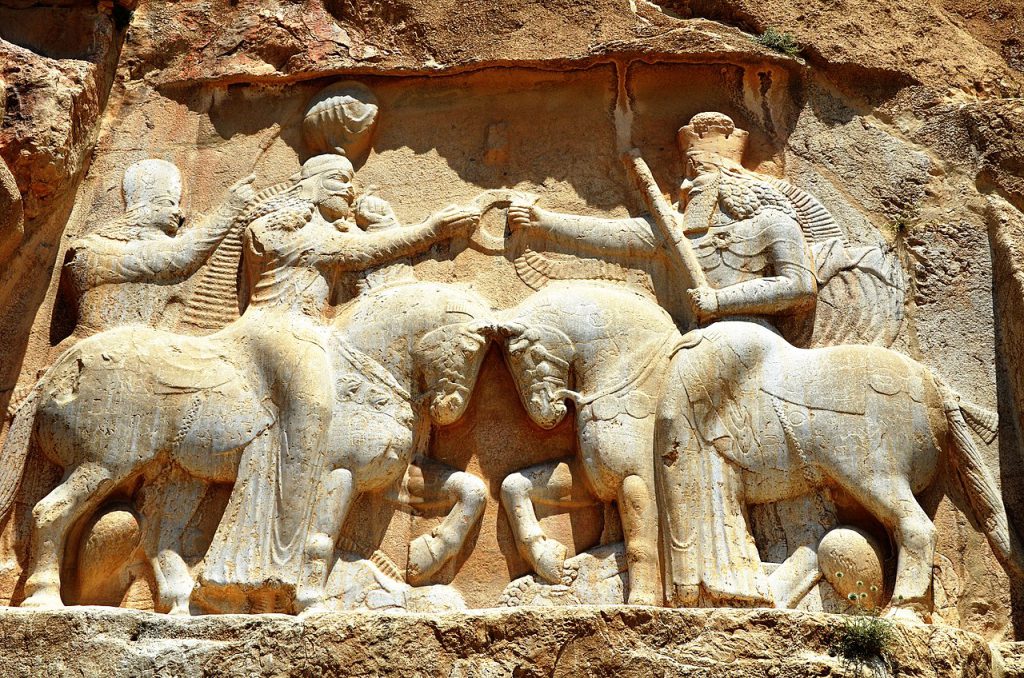
At Naghsh-e Rostam, a grandiose site located in Iran, one can find a tall natural rock wall that spans hundreds of feet, delimiting the landscape. In this incredible location, the Achaemenid kings sought to re-establish the tradition of rock-cut tombs by creating amazing sculpted facades that stand out strikingly against the recesses of the rock. The sculpted facades have three registers, with the center one occupied by a transverse rectangular element that reproduces the facade of a palace, complete with four embedded columns and double-headed bull capitals.
The upper part of the sculpted facades contains a large square bas-relief, with the lower section consisting of 28 bearers – symbols of the nations under Persian dominion – lined up on two levels like an atlas to support the king’s official litter. Above, the king stands erect, holding the emblematic arch and making a ritual sacrifice in front of the fire altar. The image of Faravahar emerges in the center of the sun disk, supported by vulture or eagle wings, as the king performs the ritual sacrifice below.
The Persian sculptors who executed the hollow smoothed the wall and left the lower part bare, like a silent beach opposite the tomb. All of these intricate details, including the Egyptian Cyma, the stone “rolling shutter” that is half lowered, and the denticulate frieze, make Naqsh-e Rostam an unparalleled example of Achaemenid architecture and sculpture.
The cross shape of the sculpted facades stands out, drawing visitors in and capturing their attention. The bas-reliefs, sculptures, and engravings are remarkably well-preserved and offer a glimpse into the incredible artistic sensibility of the Persian craftsmen.
Despite being built thousands of years ago, the inspiring architecture and spectacular engineering that characterize Naqsh-e Rostam continue to attract tourists, students, and history buffs worldwide.
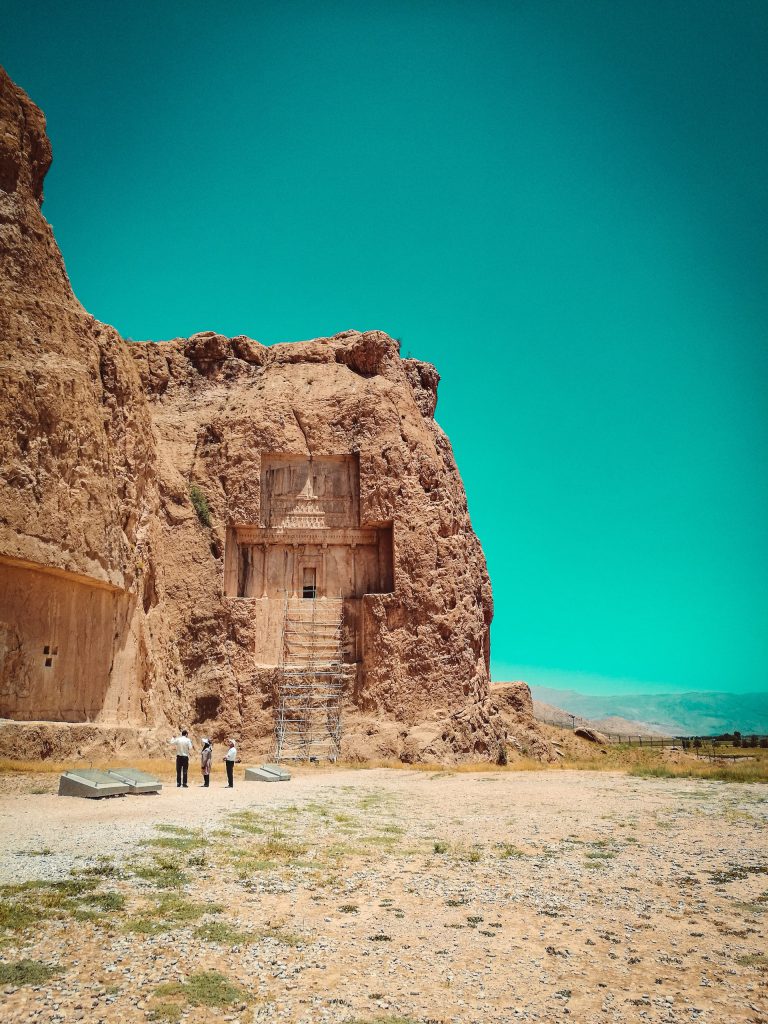
Naghsh-e Rostam: The Archetype of Iranian Rock-cut Tombs
Naghshe Rostam boasts an amazing complex of rock-hewn tombs situated well above the ground to prevent the violation. The tombs, which are no less than 72.1 ft (22 m) in height, tower over visitors who are struck by their grandeur and magnificence.
Visitors to the interior of the tombs will be immediately transported back through time, as the straight inside corridor leads to three chambers, large enough to house several sarcophagi that were intended for the king and his family. The first tomb, made for Darius the Great (522-468 BC), is situated in the middle of the rock face, with the tombs of Xerxes (486-465 BC) and Artaxerxes I (465-424 BC) located to the left, and the tomb of Darius II (423-404 BC) situated to the right – all of them boasting the same shape and size. Despite their age, the tombs are remarkably well-preserved, offering visitors a unique and enthralling glimpse into the rich history, culture, and architecture of Iran.
Naghsh-e Rostam and Persian Conundrums
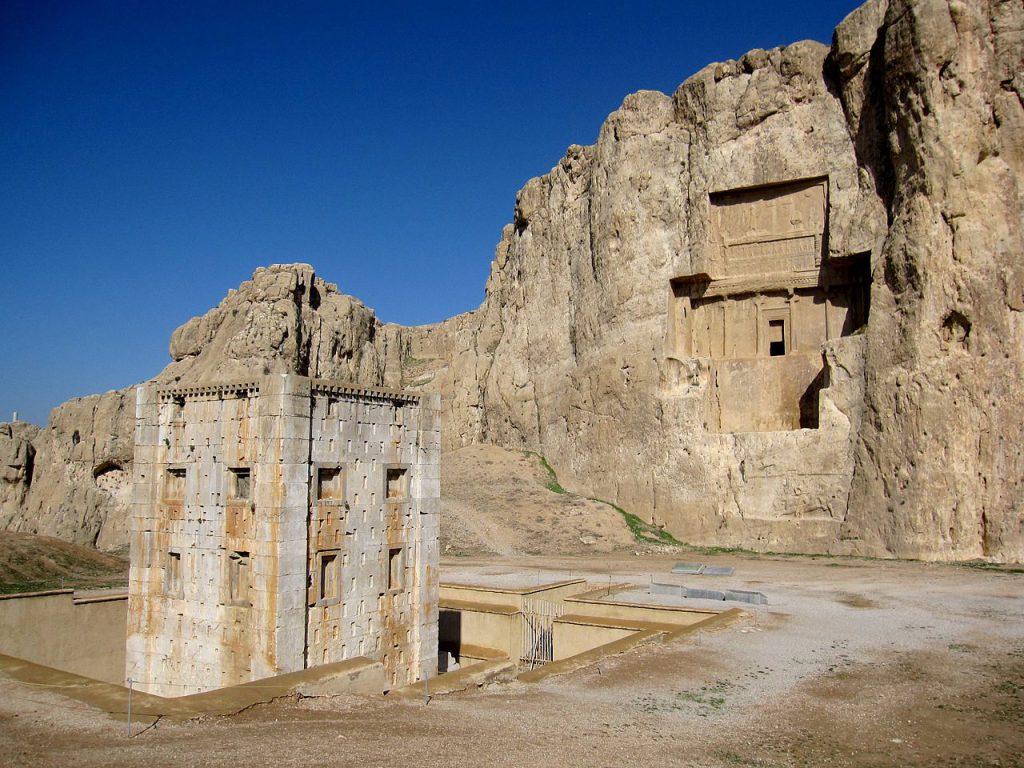
Naghsh-e Rostam, a stunning and enigmatic location, is home to a square tower with limestone masonry creating subtle alternations of pits and hollows, lending rhythm to the walls. Muslims call this tower Ka’aba-i Zartusht or Ka’aba of Zoroaster. False stone windows create strong contrasts on the walls, evocative of the Persian architectural style that is unique to this region.
The function of this structure, which is entered by a jutting stairway leading to a door halfway up the building, is hotly debated by specialists. Is it a fire altar or a library that once housed the texts of the Avesta, the sacred scripture of the Zoroastrians? Or was it a temporary tomb to hold bodies until the proper tomb was built? In Pasargadae, an analogous edifice exists, constructed with the same techniques, but its purpose remains a mystery.
The last Achaemenid kings Artaxerxes II (404-358 BC) and Artaxerxes III (358-338 BC) decided to build their tombs directly above the palaces of Persepolis, in the rock face of the mountain known as Kuh-i Rahmat. Meanwhile, the tomb of Darius III (335-330 BC), whom Alexander the Great defeated, was never completed.
This incredible location reveals intriguing Persian conundrums at every turn, inviting visitors to explore and unravel the mysteries of the past. From the magnificent rock-cut tombs to the timeless architecture, each intricacy of Naghshe Rostam has a story to tell.
Naghsh-e Rostam and A Reflection of Sassanian and Achaemenid Artistry
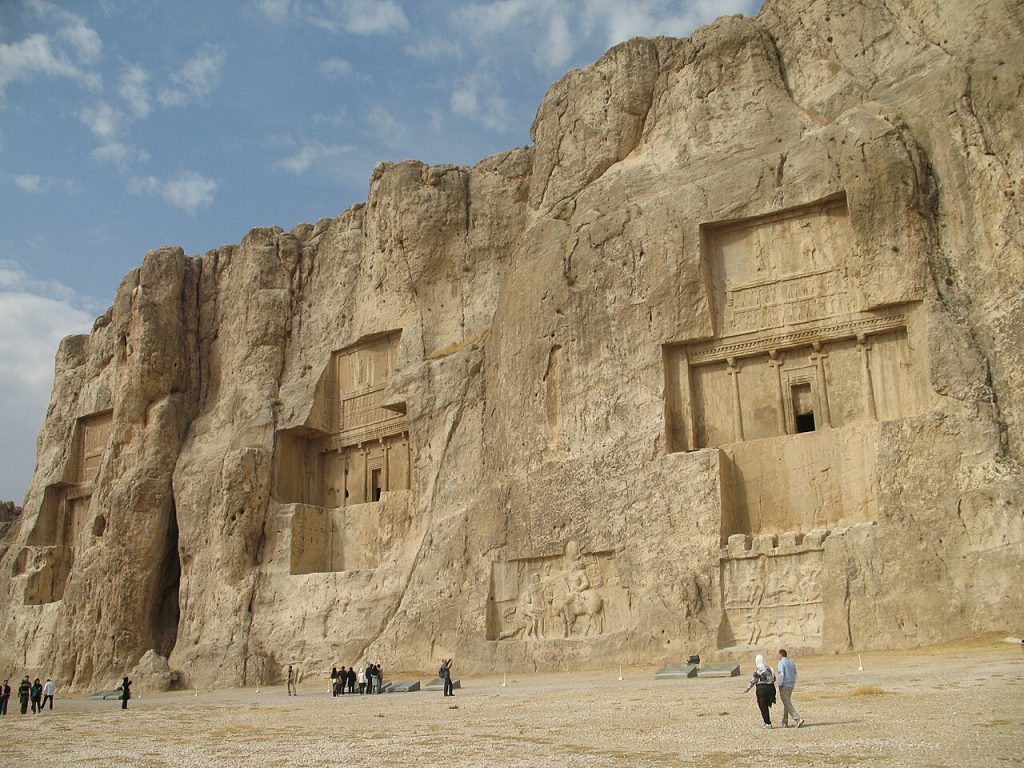
Throughout its many centuries of existence, the bas-reliefs at Naghsh-e Rostam carved in the rock have served as time capsules, capturing the most significant events of the Achaemenid and Sassanian dynasties.
The Sassanian kings considered themselves rightful heirs to the Achaemenid Empire, and this led to the revival of rock carving art, which they used to preserve their history and glory. The Sassanian rock panels created almost eight centuries after Naqsh-e Rustam’s initial establishment depict investiture and triumphal scenes at prestigious locations, such as Naqsh-e Rustam’s cliff face. These rock panels celebrate the Sassanian monarchs’ victories and demonstrate the Achaemenid legacy of paying homage to the glory of their respective reigns.
One of the most famous and awe-inspiring carvings at Naghshe Rustam is the Investiture of Ardeshir I. Ardeshir I’s victory over the Parthian King Artabanus V was previously glorified in a huge rock-cut fresco, depicting an animated battle scene at Firuz Abad. But Ardeshir I wanted to immortalize this key moment in his reign again, and this is how Investiture of Ardeshir I came to be. This bas-relief features the king mounted on a horse, with Ahura Mazda, the Zoroastrian God, standing by his side and the same size as the king.
The king is shown receiving a ring of power, “Deihim,” from Ahura Mazda, solidifying his status as the rightful king. Meanwhile, the defeated Parthian King, Artabanus IV, is on one side, and the spirit of evil, Ahriman, is on the other, both being trampled by the king and god.
Through these rock carvings, we can gain a glimpse of ancient Iranian history and learn about the artistic expression of the Achaemenid and Sassanian dynasties. Naghshe Rustam stands as a testament to the skill and beauty of rock carving, a cultural and historical gem that welcomes visitors from all over the world to marvel at the breathtaking artistry and the stories it tells us.
Naghsh-e Rostam and An Illustration of the Roman-Persian Wars
The victory of the Sasanian Empire over the Roman-Byzantine empire is depicted in one of the most outstanding pieces of art found at Naghshe Rustam. The scene of Valerian’s capture showcases the Sassanian king Shapur I (241-272 AD) subduing Emperor Philip the Arab, who is kneeling in surrender. Valerian, the standing Roman emperor, is portrayed holding out his arms as a sign of surrender. These two victories exemplify the centuries-long conflicts in the Roman-Persian Wars, one of the longest and most bitter wars in history.
The Roman-Persian Wars were a series of battles between the two mighty empires, the Greco-Roman World and the Parthian and Sasanian Empires. These wars began under the late republic and continued through the Roman and Byzantine empires. Several vassal kingdoms and allied nomadic nations, in the form of buffer states and proxies, also played a critical role in the wars. The Roman-Persian Wars ended with the early Muslim conquests that caused the fall of the Sasanian Empire and significant territorial losses for the Byzantine Empire shortly after their last war.
The Mysterious Investiture Scene of Narseh
Among the captivating bas-reliefs at Naghshe Rustam is the Investiture Scene of Narseh, dating back to the 3rd century. The carving features the Sasanian king Narseh, who ruled between c. 293-303, receiving the ring of royal power from a female figure. Previous theories identified the female figure as the goddess of water, Anahita. However, some scholars have challenged this theory, suggesting that the female figure is more likely to represent a queen – possibly, Queen Shapurdokhtak.
The portrayal of Narseh in the investiture scene has raised some scholarly questions, as the king’s manner is not present as one would expect in the presence of a goddess. Despite the mystery surrounding the identity of the female figure, the Investiture Scene of Narseh remains a spectacular carving that engages viewers with its detailed artistic skills and the enigmatic story it tells.
The Battle Scene of Shapur II
The Sassanian Empire was renowned for its military might, and this is evident in the epic Battle Scene of Shapur II, known for its size and grandeur. Found beneath the tomb of Darius II at Naghshe Rustam, this carving measures 7.60 meters in length and about three meters in width. The carving showcases a victorious Sassanian king on horseback, plunging a long spear into the enemy’s neck, symbolizing the empire’s military superiority.
Though the identity of the victorious king and the exact date of the battle is unknown, scholars believe that it belongs to the reign of Shapur II (309-379) due to the resemblance of the king’s crown shape to Shahpour II’s crown. The face of the rider has unfortunately been detracted by time, but his beard and ring are still visible, adding to the mysterious and fascinating history of this battle carving. The carving presents a compelling visual and artistic display of the Sassanian Empire’s military strength and its impact on the world stage, emphasizing the dynasty’s strong leadership while delivering a sense of triumph and glory through their victories.
The Magnificent Darius Inscription at Naghsh-e Rostam
The inscriptions at Naghsh-e Rostam provide a glimpse into the triumphs of ancient Persian kings, and the Darius Inscription is one of the most legendary. Located on the top of Darius the Great’s tomb, the Dania Naqsh-e Rostam Inscription describes Darius’s many great accomplishments and victorious campaigns.
The precise date of the inscription is unknown, but it is believed to have been included in the last decade of Darius’s reign. Like other inscriptions by Darius, this one lists the territories controlled by the Achaemenid Empire, including the Indus and Gandhara regions in India, confirming the Achaemenid’s rule over the Indus Valley. The inscription serves as a testament to Darius’s leadership and highlights the many triumphs and great achievements of his reign, giving visitors a unique glimpse into the iconic King of Kings’ life and legacy. It’s a true work of art and an enduring symbol of the mighty Persian empire, demonstrating the artistic and archaeological wonder of Naghshe Rustam.
How to Get to Naghsh-e Rostam
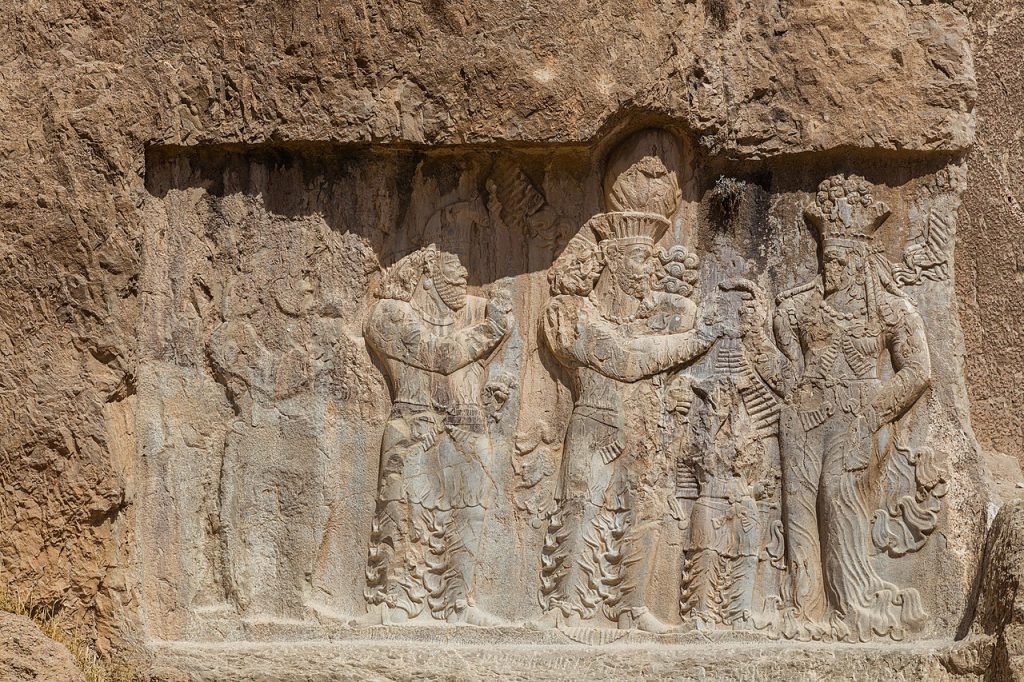
Getting to Naghsh-e Rostam by car is a straightforward and scenic journey from Shiraz. Begin your adventure by heading onto the Shiraz-Marvdasht Highway, which sets the stage for a picturesque drive through the lush landscapes of Fars province. After approximately 60 kilometers, you’ll reach the Marvdasht-Saadat Shahr Road. This route not only leads you directly to the archaeological marvel of Naqsh-e Rostam but also offers glimpses of the rich cultural heritage that defines this region.
Last Words: Explore the Best of Naghsh-e Rostam with a Customized Tour
Naghsh-e Rostam, close to Persepolis, showcases the grand ideas of Darius the Great. Instead of traditional house-shaped mausoleums, Darius had massive tombs carved directly into the mountain, creating a unique and impressive sight. These tombs are large and can be seen from far away, adding to their grandeur. Despite being thousands of years old, the detailed carvings are still well-preserved, drawing visitors and history enthusiasts worldwide.
If you are planning to visit Iran and explore the country’s fascinating historical landmarks such as Naghsh-e Rostam, it is highly recommended to opt for a customized and tailored tour. When it comes to Iran tours and travel packages, To Iran Tour is a professional and reliable travel agency that can help you design the perfect itinerary based on your interests and expectations.
To Iran Tour’s experienced team can provide you with expert advice and guidance to help you plan a trip that is tailored to your needs. They can help you discover the best of Iran’s historical landmarks, such as Naghsh-e Rostam, as well as other popular attractions and hidden gems.

